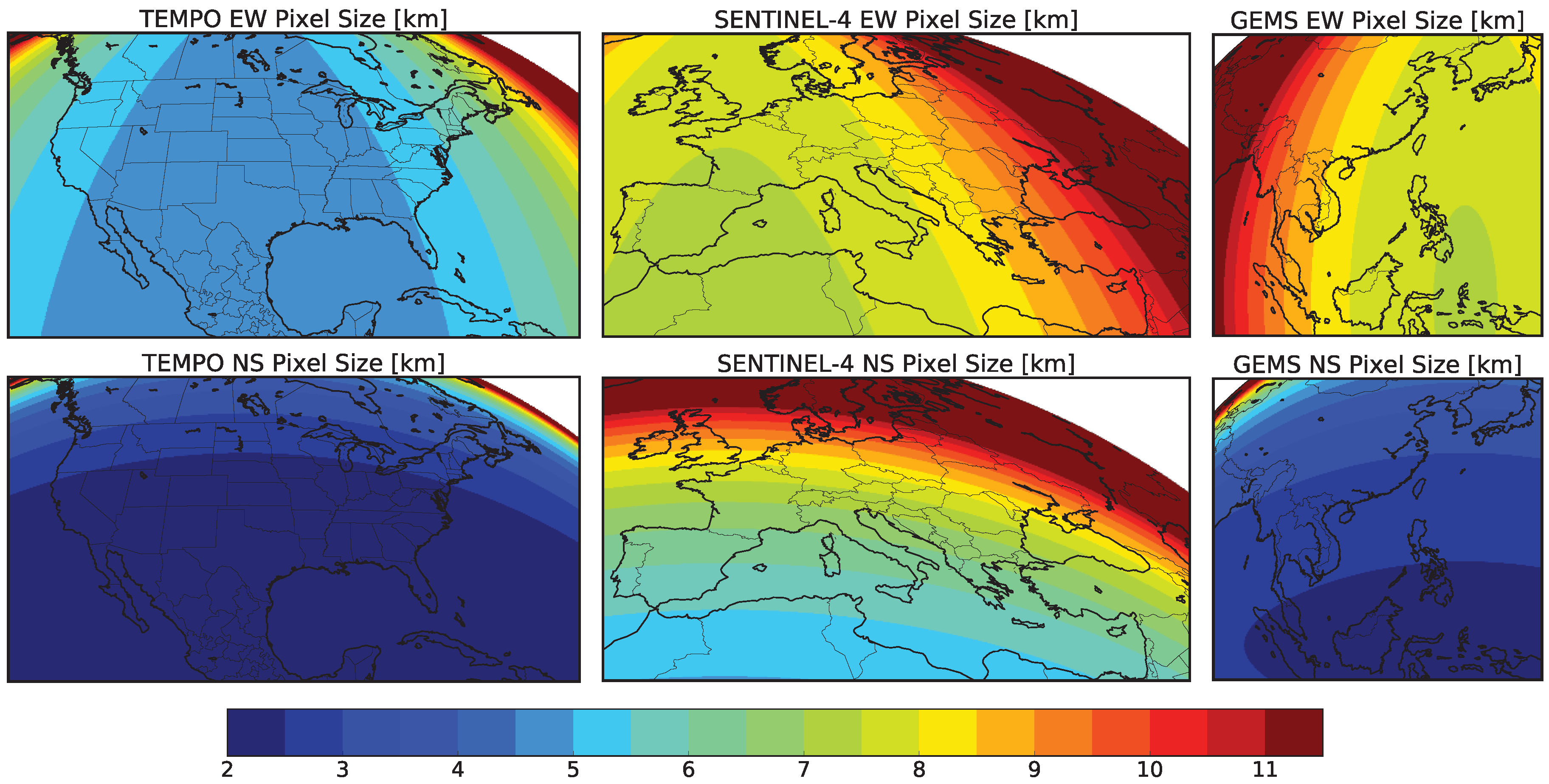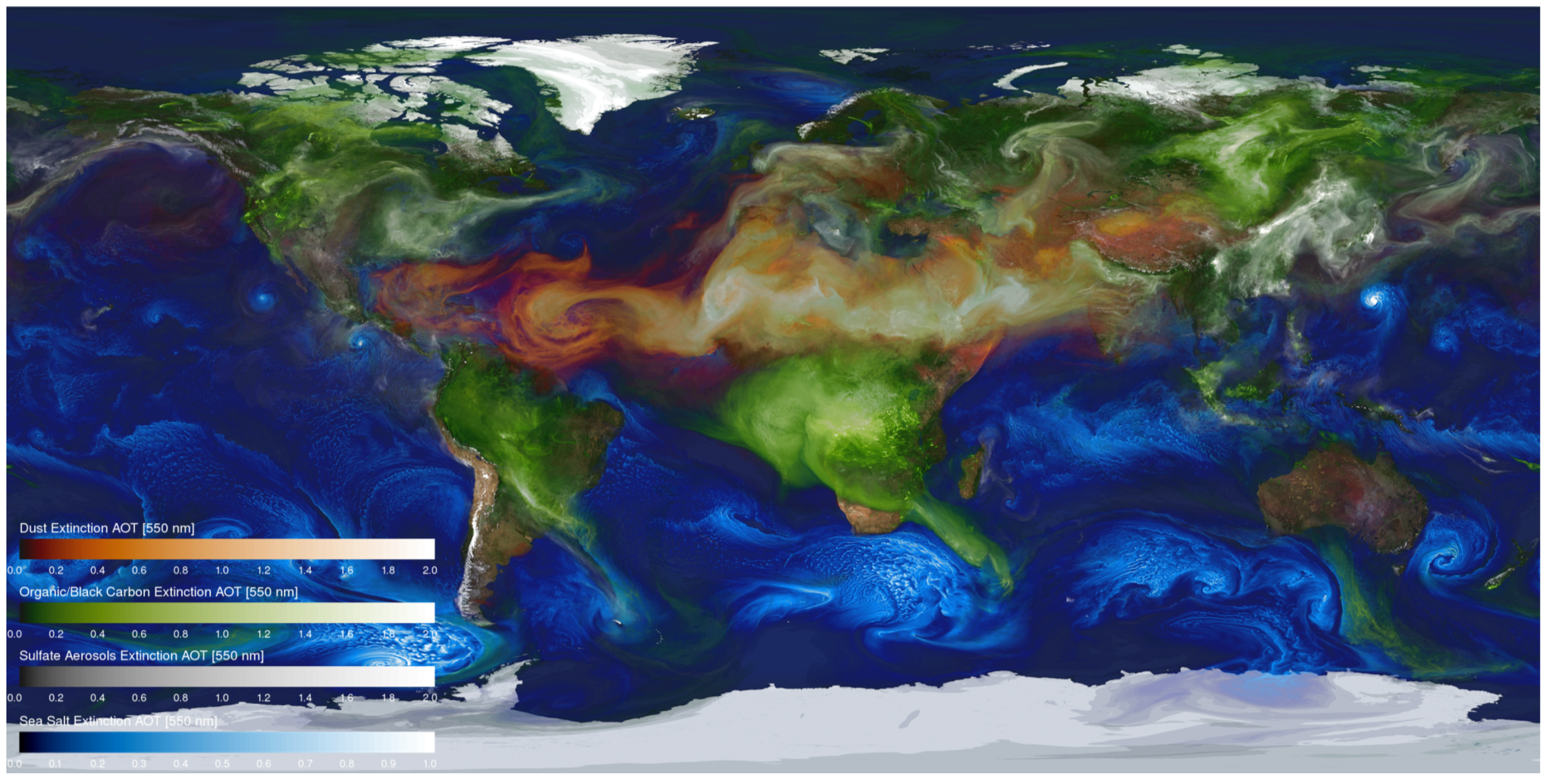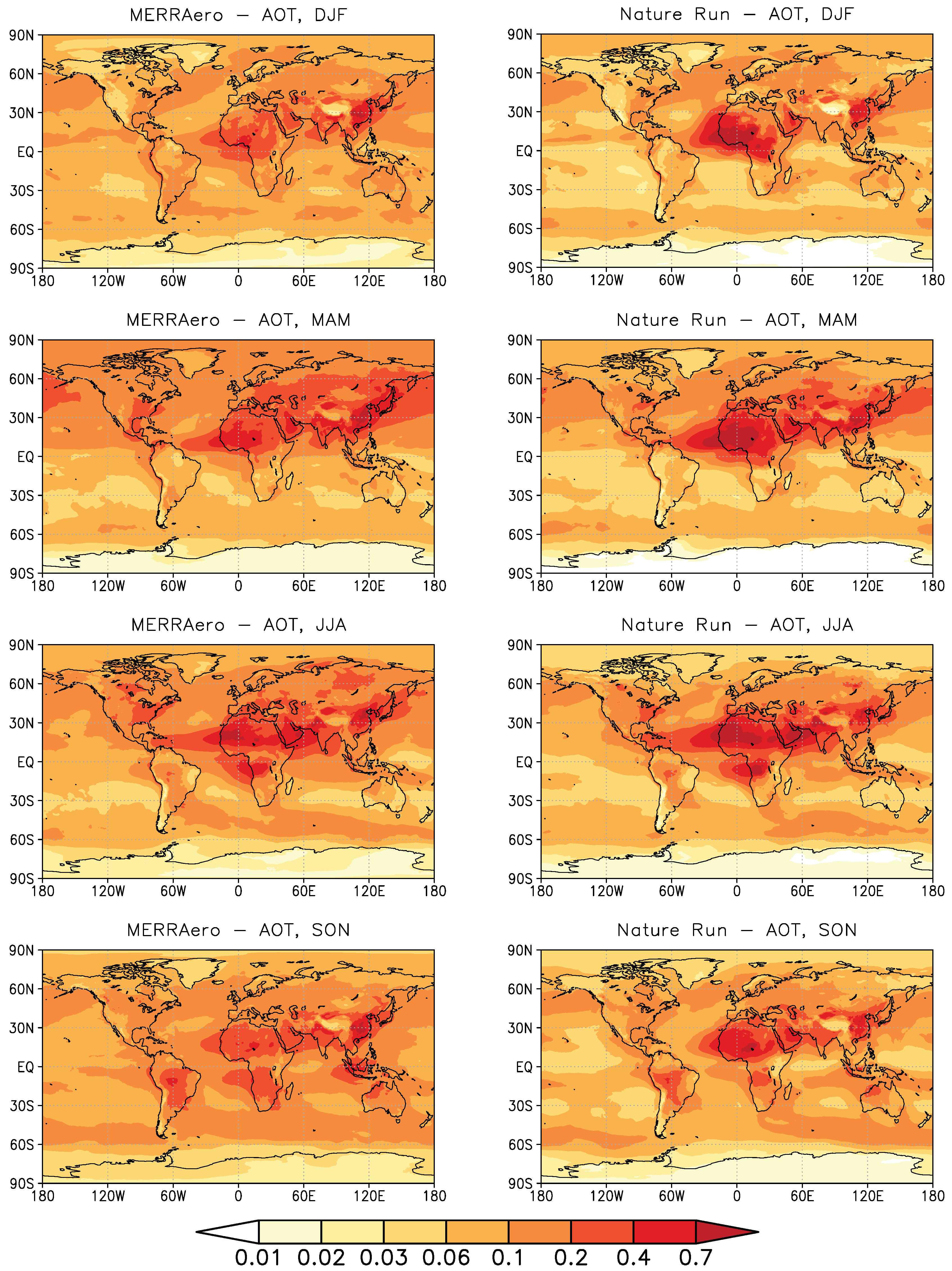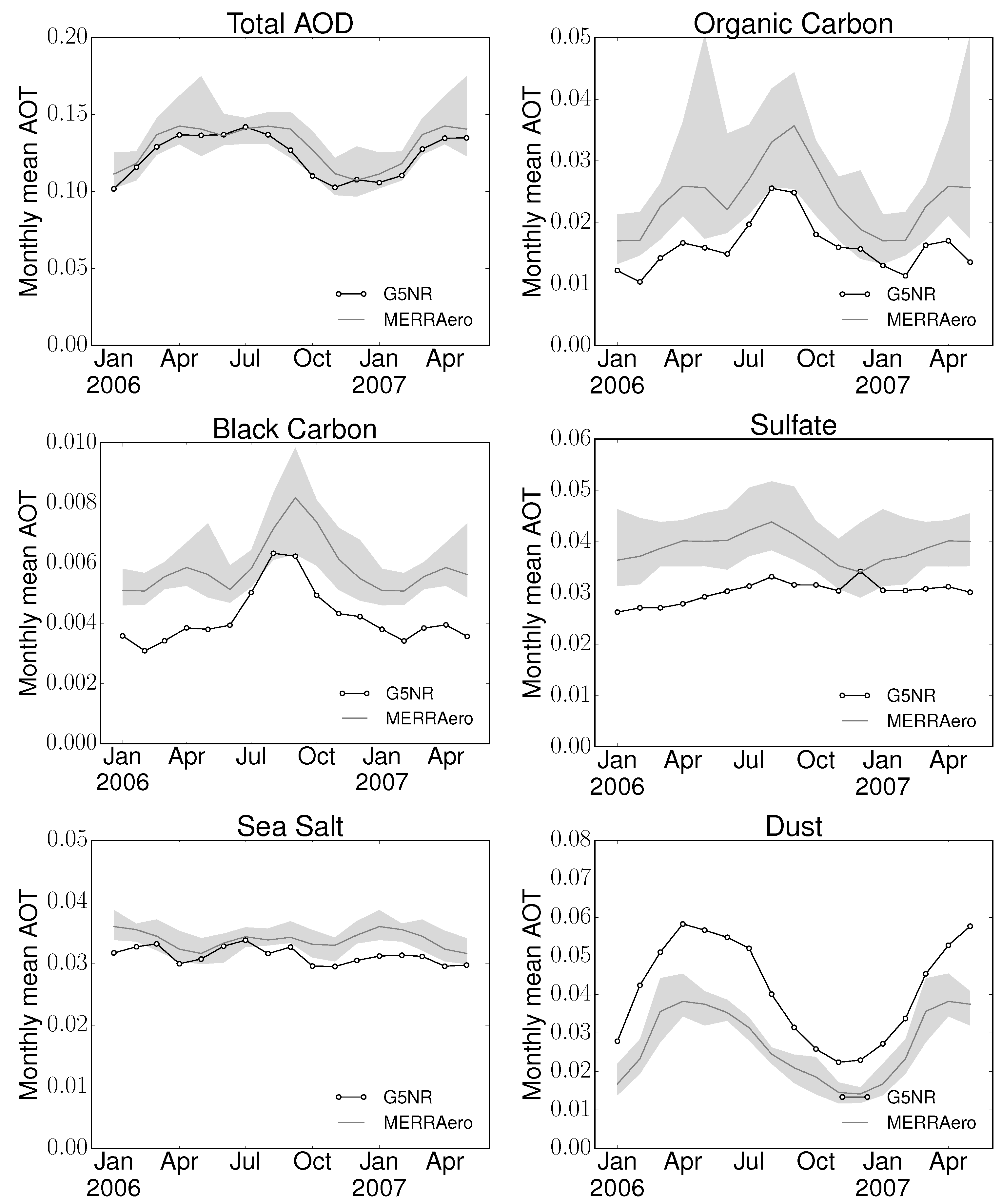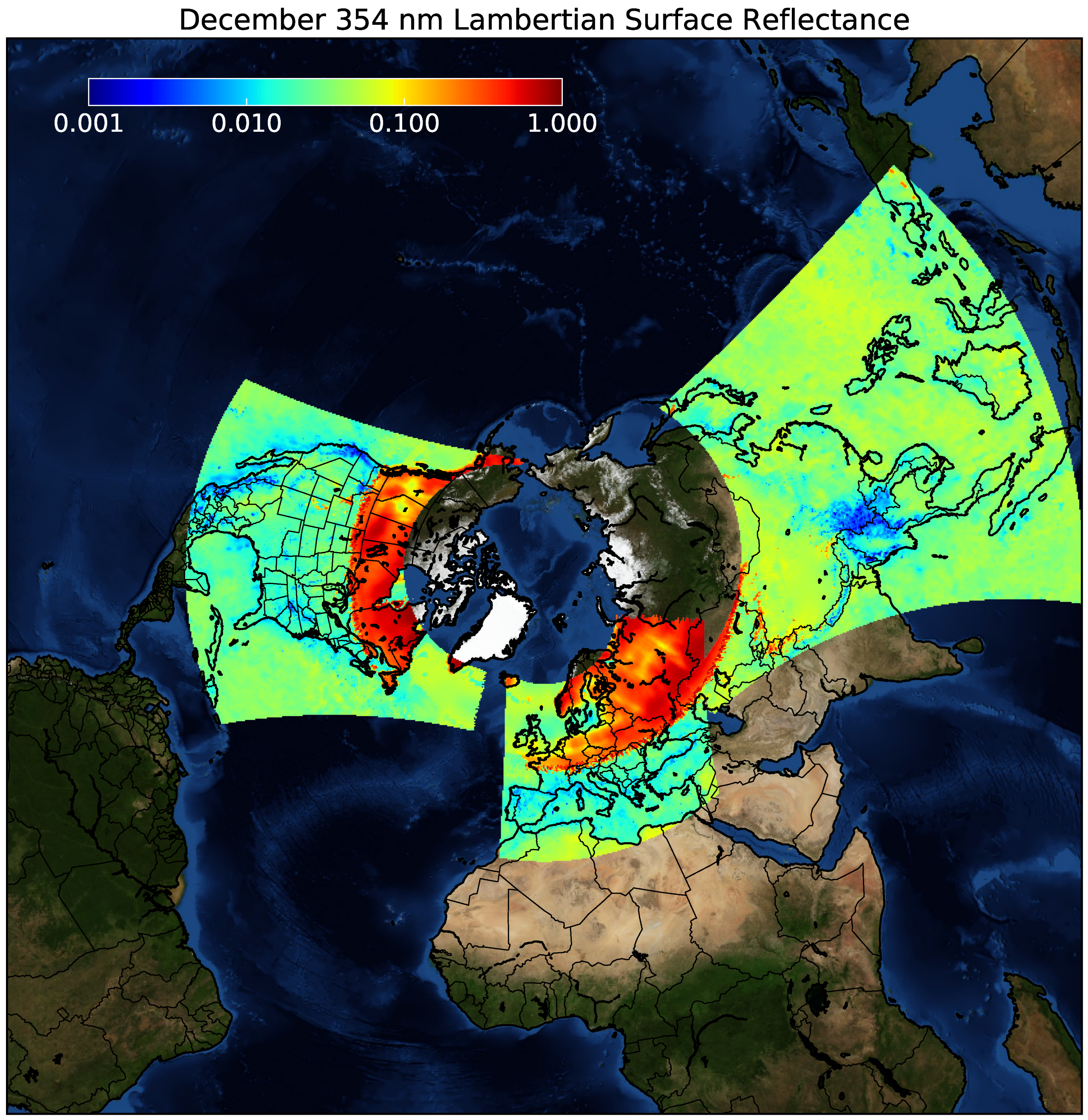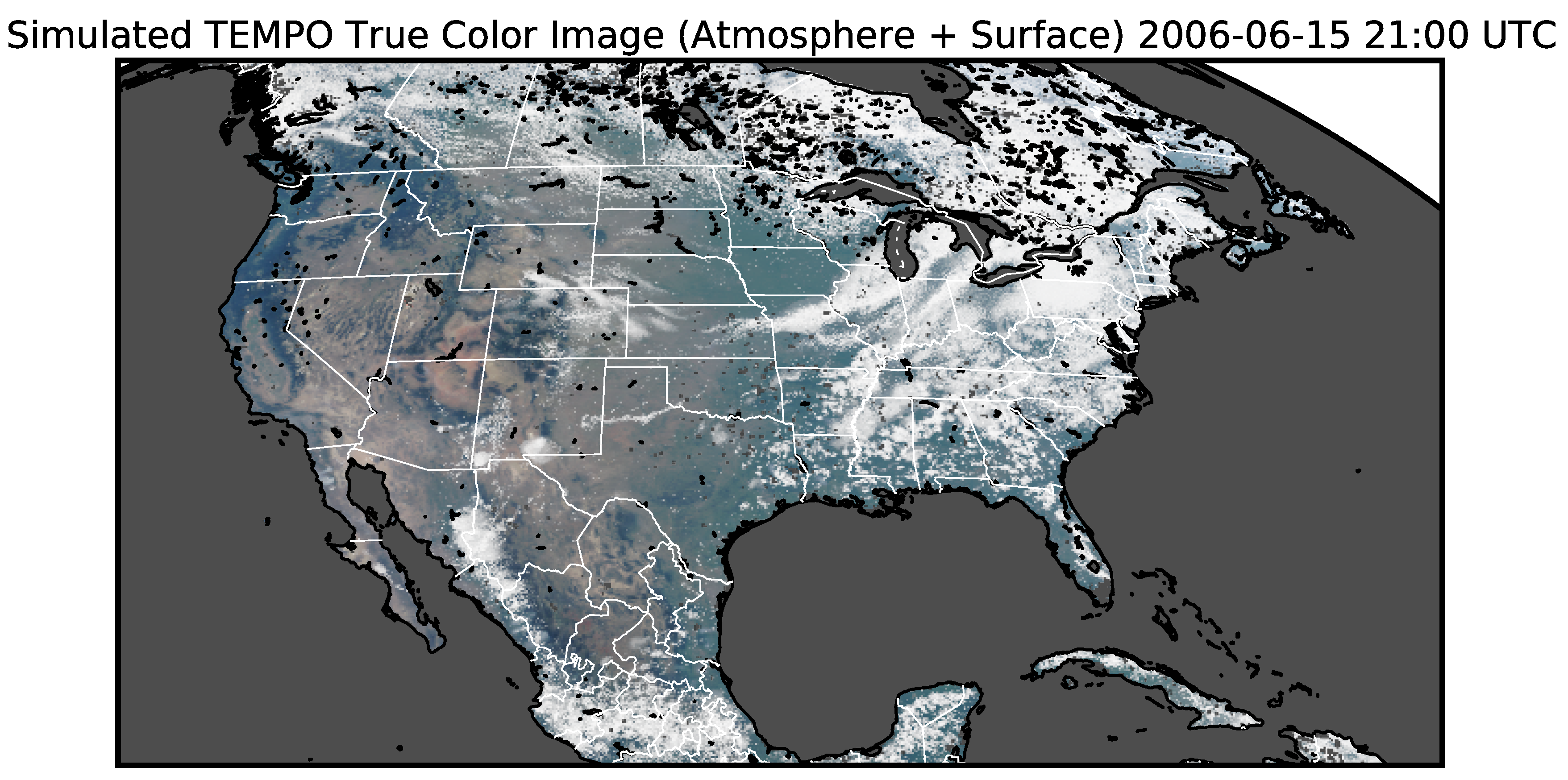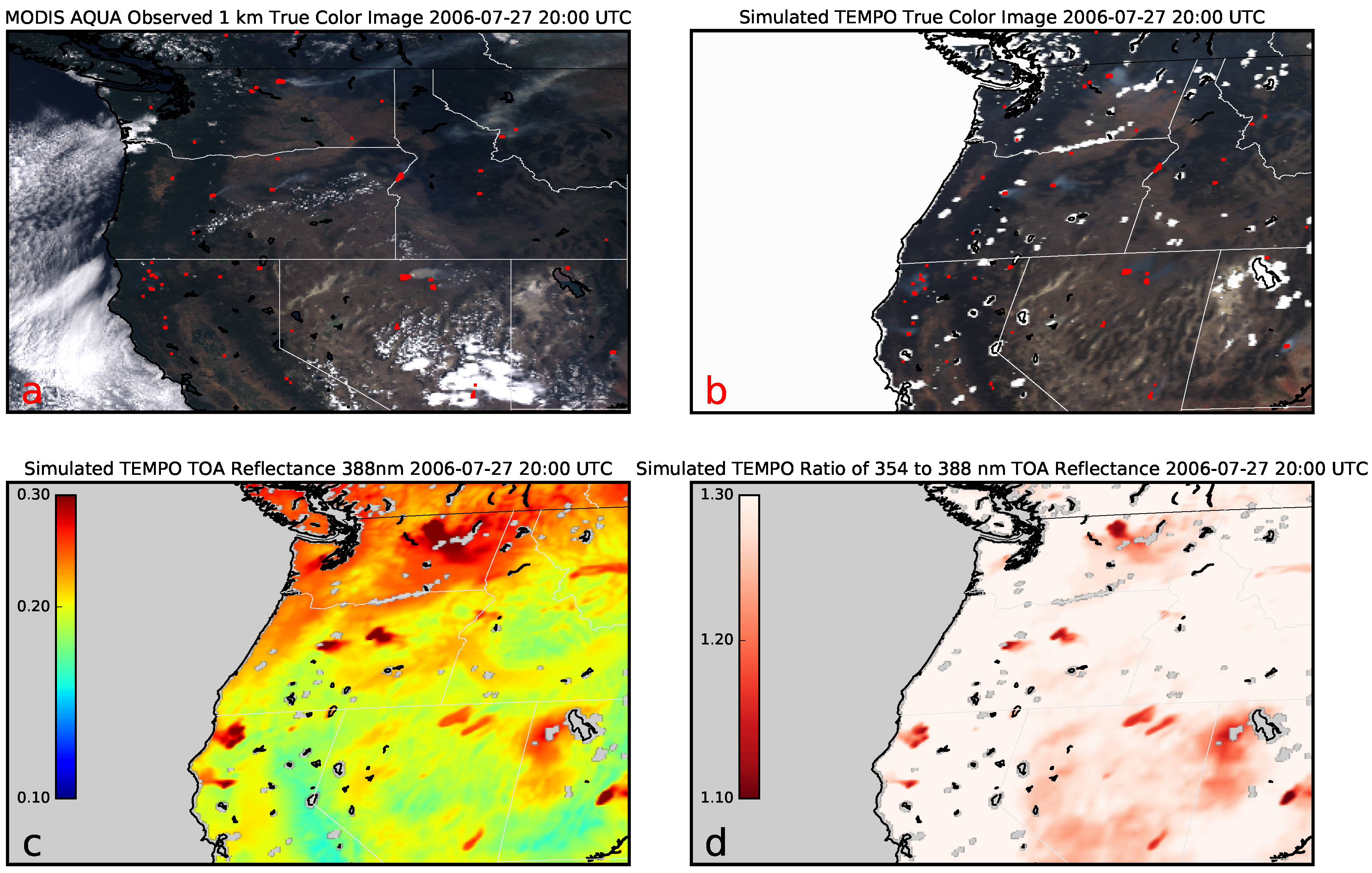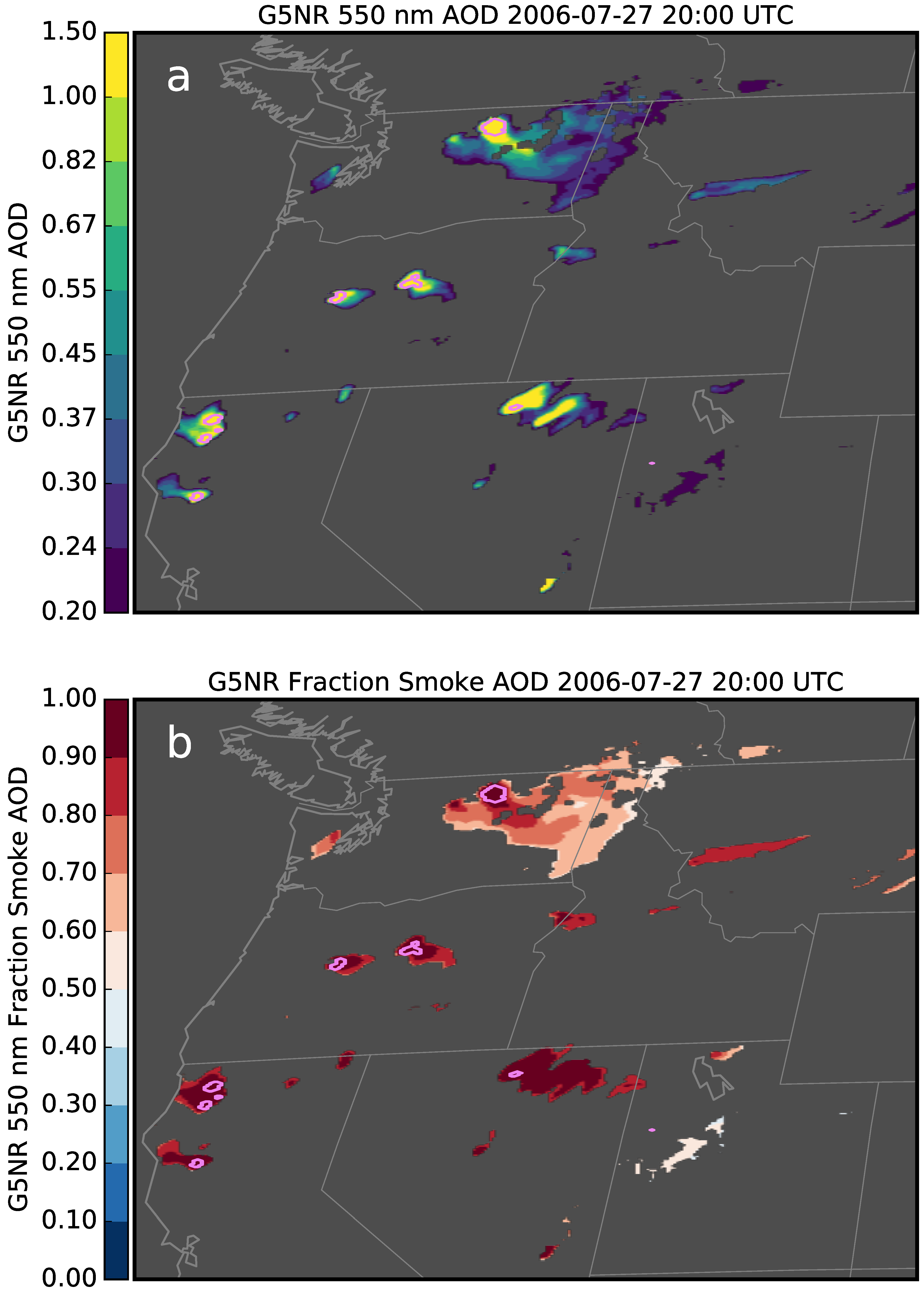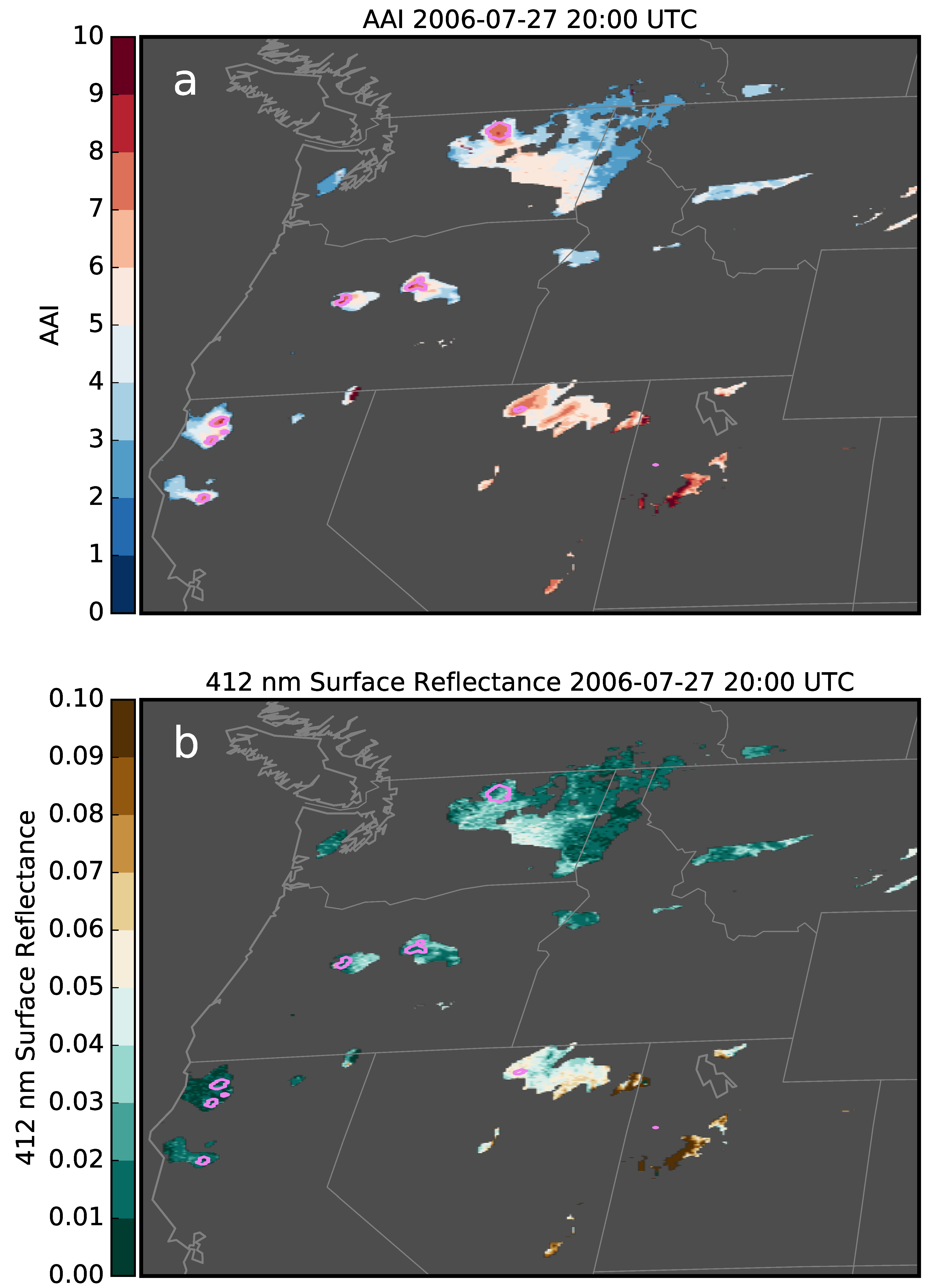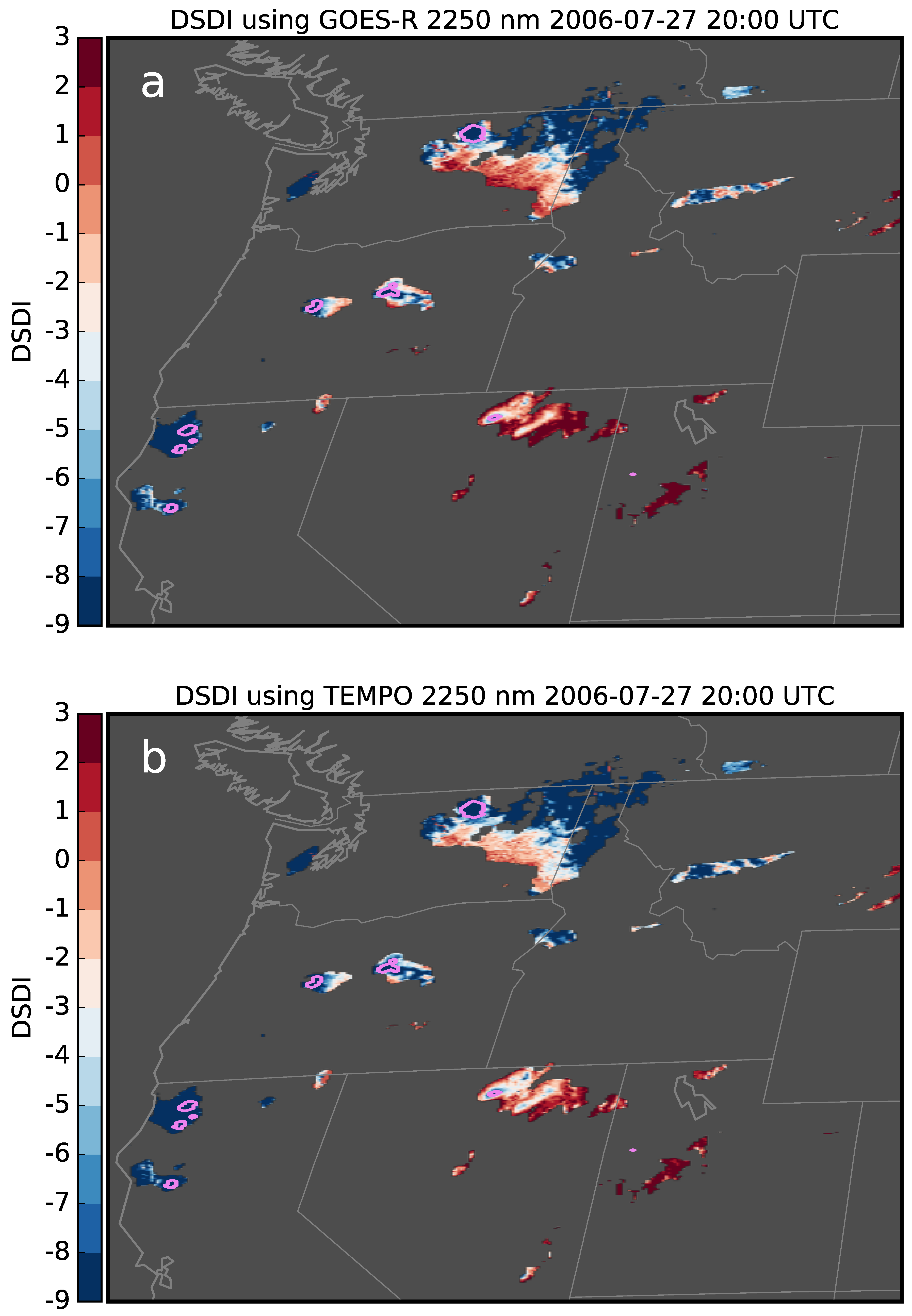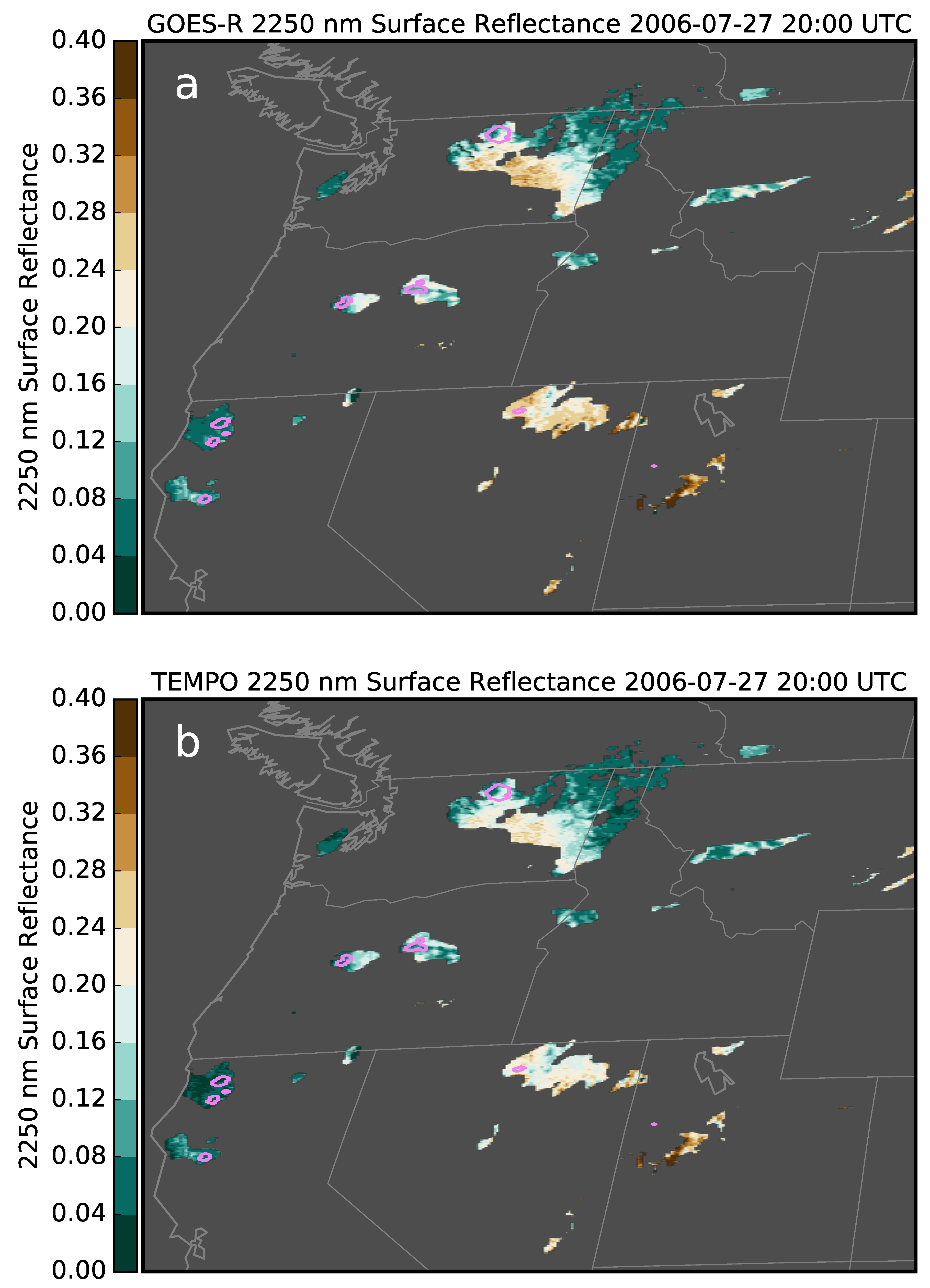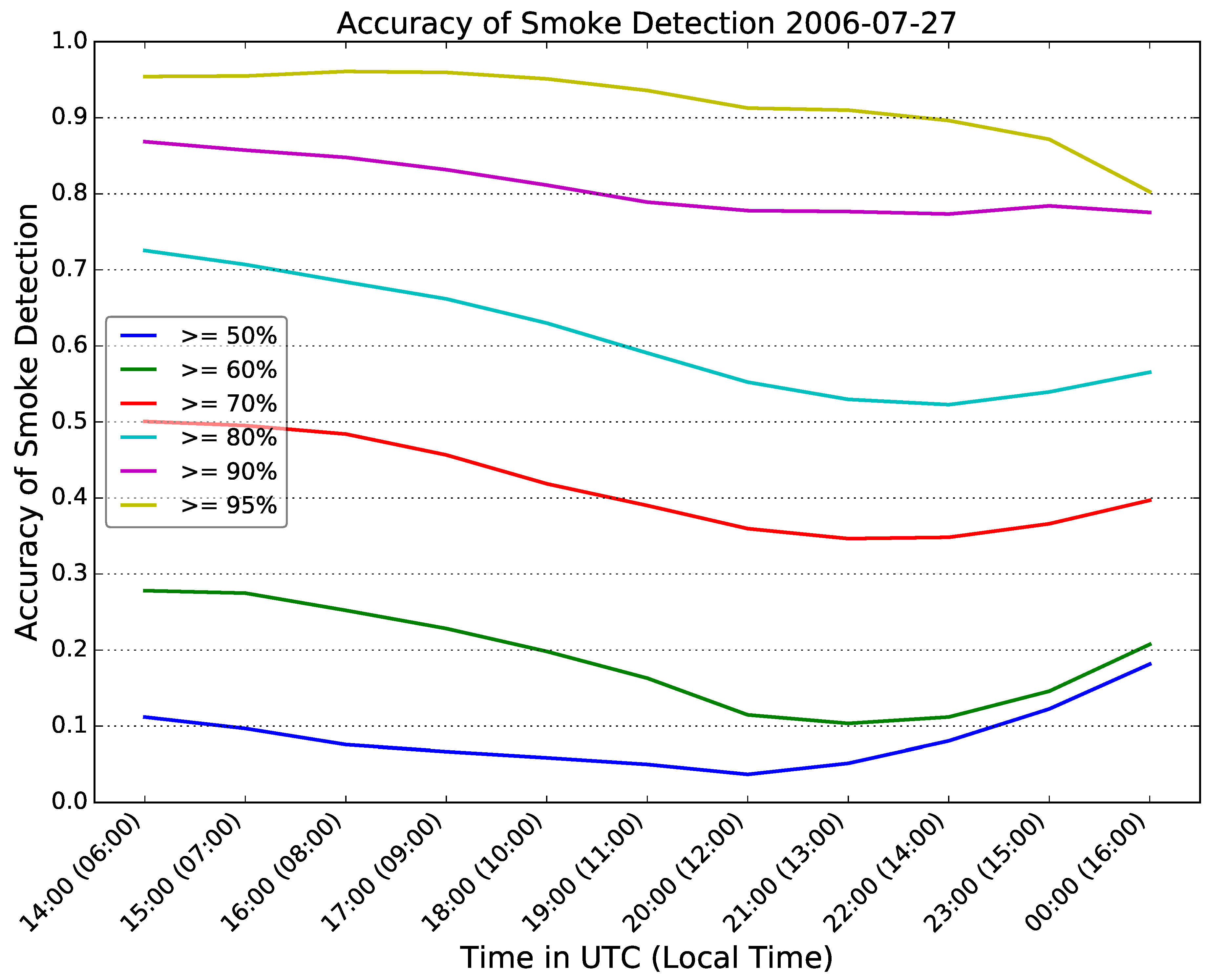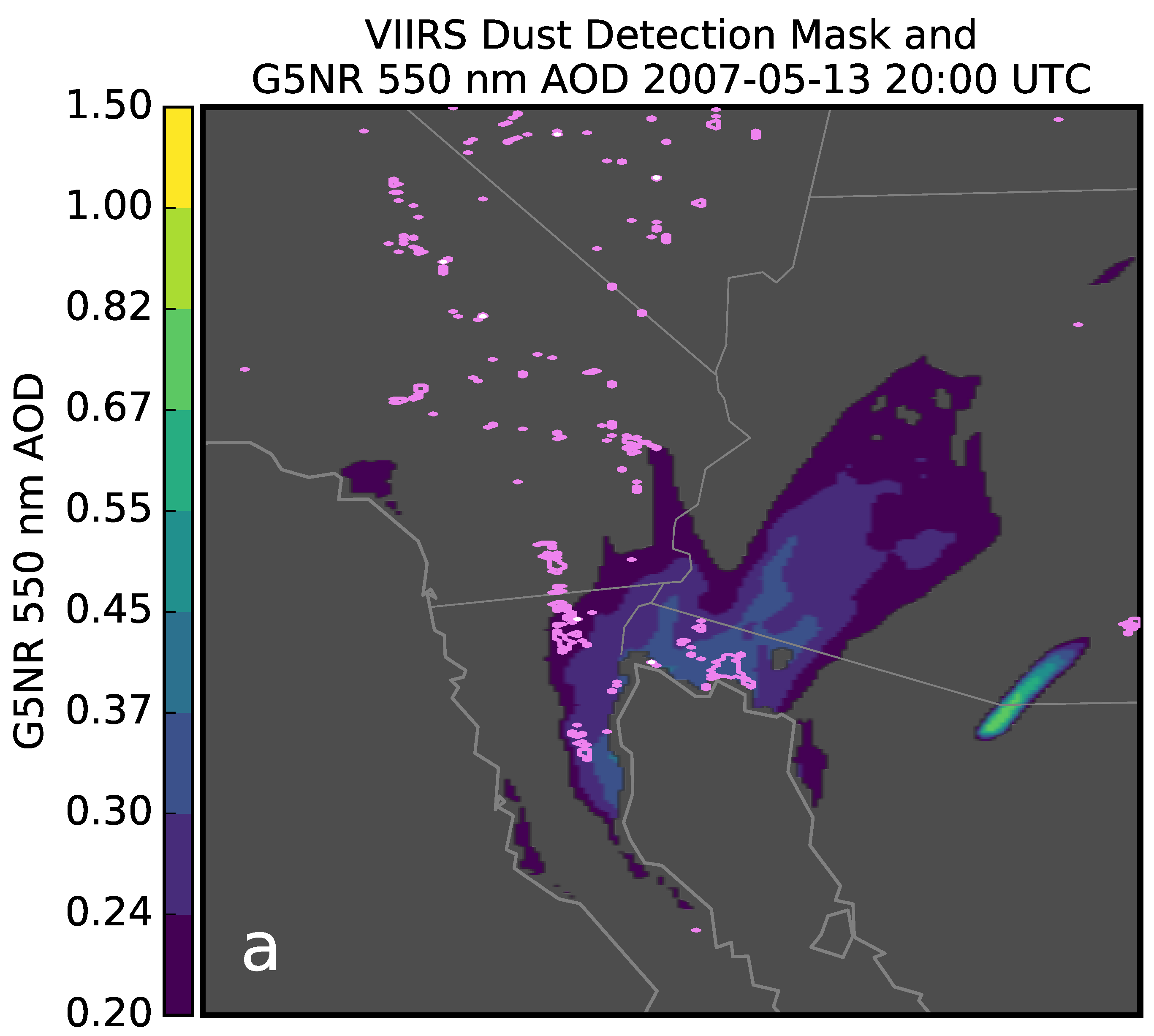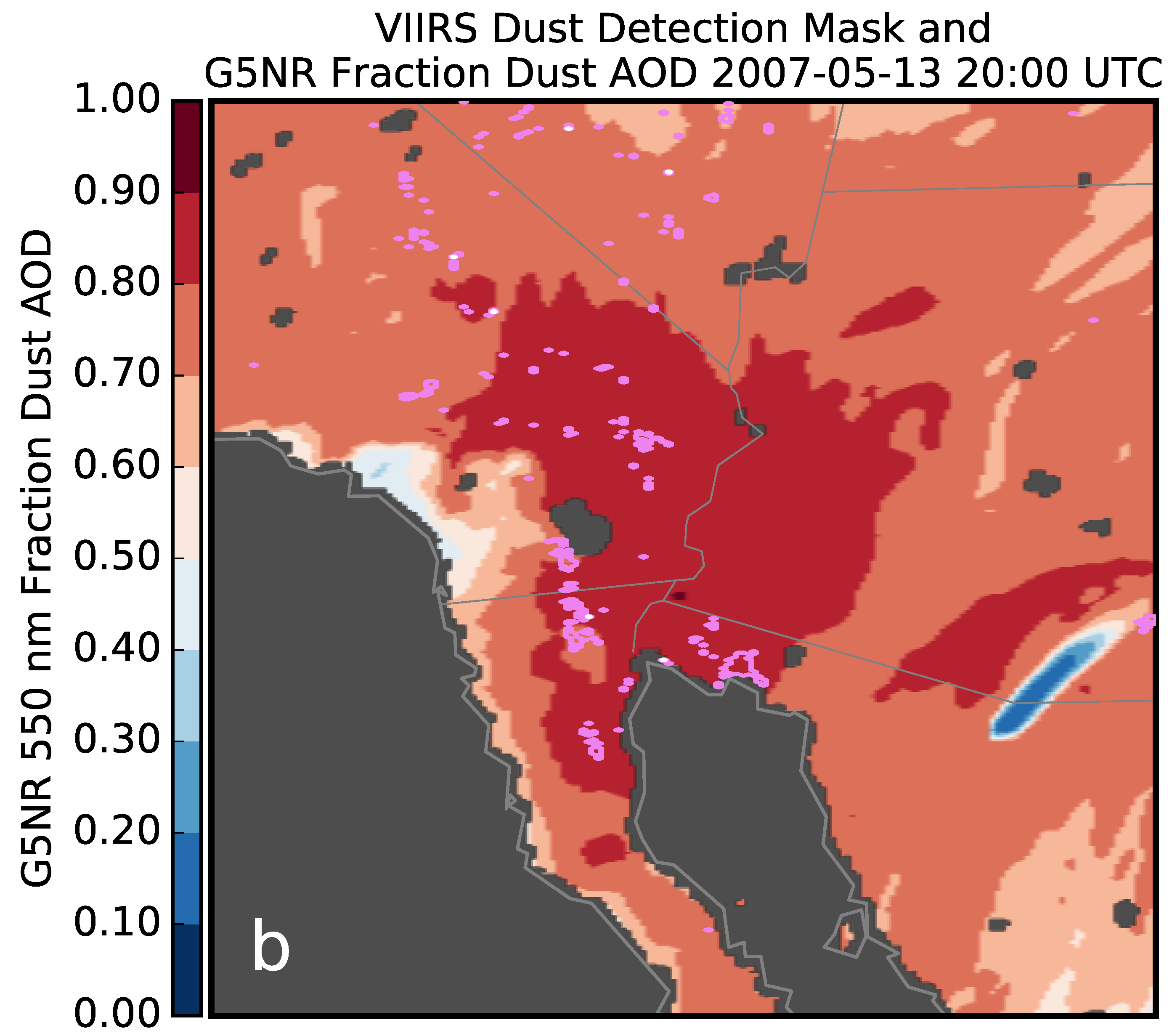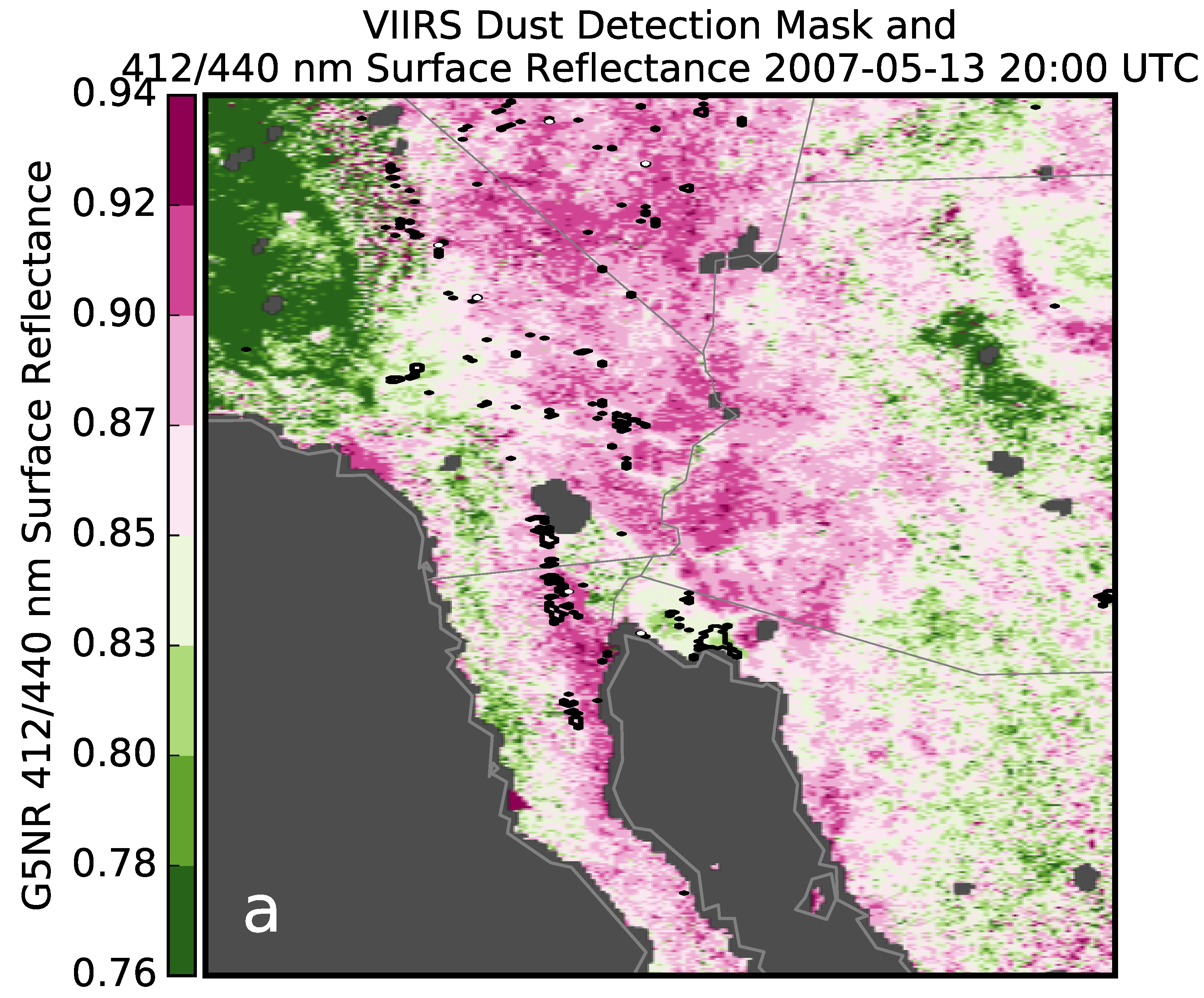Author Contributions
Conceptualization, P.C. (Patricia Castellanos), A.M.d.S., A.S.D. and S.K.; Data curation, P.C. (Patricia Castellanos), A.S.D., V.B., R.C.G. and P.C. (Pubu Ciren); Formal analysis, P.C. (Patricia Castellanos), A.S.D., V.B. and P.C. (Pubu Ciren); Funding acquisition, A.M.d.S. and S.K.; Investigation, P.C. (Patricia Castellanos) and P.C. (Pubu Ciren); Methodology, P.C. (Patricia Castellanos), A.M.d.S. and A.S.D.; Project administration, A.M.d.S.; Resources, A.M.d.S. and S.K.; Software, P.C. (Patricia Castellanos); Supervision, A.M.d.S. and S.K.; Validation, P.C. (Patricia Castellanos), A.S.D. and V.B.; Visualization, P.C. (Patricia Castellanos), A.S.D. and V.B.; Writing—original draft, P.C. (Patricia Castellanos), A.S.D. and P.C. (Pubu Ciren); Writing—review & editing, P.C. (Patricia Castellanos), A.M.d.S. and V.B.
Figure 1.
Spatial resolution of TEMPO, SENTINEL-4, and GEMS. Pixel sizes were determined according to a geostationary projection on the globe from the satellites’ respective longitudes.
Figure 1.
Spatial resolution of TEMPO, SENTINEL-4, and GEMS. Pixel sizes were determined according to a geostationary projection on the globe from the satellites’ respective longitudes.
Figure 2.
The 7 km G5NR aerosol simulation for 27 July 2006 at 12 Z. Blue shading corresponds to sea salt concentration, green shading corresponds to black and organic carbon concentrations, red-orange shading corresponds to dust, and white shading corresponds to sulfate.
Figure 2.
The 7 km G5NR aerosol simulation for 27 July 2006 at 12 Z. Blue shading corresponds to sea salt concentration, green shading corresponds to black and organic carbon concentrations, red-orange shading corresponds to dust, and white shading corresponds to sulfate.
Figure 3.
2006 seasonal mean 550 nm AOD from the MERRAero aerosol reanalysis (left column) and the G5NR (right column). Time-averaged values for DJF, MAM, JJA, and SON are organized from top to bottom.
Figure 3.
2006 seasonal mean 550 nm AOD from the MERRAero aerosol reanalysis (left column) and the G5NR (right column). Time-averaged values for DJF, MAM, JJA, and SON are organized from top to bottom.
Figure 4.
Time series of global monthly mean 550 nm AOD. Results from the G5NR simulation are in black. The monthly mean climatology from the MERRAero reanalysis is shown in gray; the shaded area encloses the minimum and maximum monthly means from the 14-year time series (2002–2016), while the gray line represents the mean.
Figure 4.
Time series of global monthly mean 550 nm AOD. Results from the G5NR simulation are in black. The monthly mean climatology from the MERRAero reanalysis is shown in gray; the shaded area encloses the minimum and maximum monthly means from the 14-year time series (2002–2016), while the gray line represents the mean.
Figure 5.
Vertical profiles of aerosol attenuated backscatter coefficient at 532 nm over the African dust region (60° W – 20° E, 0° N – 30° N). On the left are time-averaged retrievals from CALIOP for July 2011. On the right is the G5NR simulation July 2006.
Figure 5.
Vertical profiles of aerosol attenuated backscatter coefficient at 532 nm over the African dust region (60° W – 20° E, 0° N – 30° N). On the left are time-averaged retrievals from CALIOP for July 2011. On the right is the G5NR simulation July 2006.
Figure 6.
Same as
Figure 5 but for the southern Africa biomass burning region (10° W – 30° E, 0° S – 30° S).
Figure 6.
Same as
Figure 5 but for the southern Africa biomass burning region (10° W – 30° E, 0° S – 30° S).
Figure 7.
Simulated surface reflectance according to the MAIAC BRDF retrieval at 670 nm for the TEMPO sun-sensor geometry at 17–22 Z on 31 December 2005. Changes in the surface reflectance throughout the day are due to the bidirectional nature of the surface reflectivity.
Figure 7.
Simulated surface reflectance according to the MAIAC BRDF retrieval at 670 nm for the TEMPO sun-sensor geometry at 17–22 Z on 31 December 2005. Changes in the surface reflectance throughout the day are due to the bidirectional nature of the surface reflectivity.
Figure 8.
Lambertian equivalent reflectance mapped to the TEMPO grid from a 0.25° monthly climatology based on TOMS observations.
Figure 8.
Lambertian equivalent reflectance mapped to the TEMPO grid from a 0.25° monthly climatology based on TOMS observations.
Figure 9.
Simulated 550 nm TOA reflectance as would be observed by the geostationary constellation over 15 h on 28 July 2006.
Figure 9.
Simulated 550 nm TOA reflectance as would be observed by the geostationary constellation over 15 h on 28 July 2006.
Figure 10.
Simulated true color image for 15 June 2006 21 UTC in the G5NR simulation as would be observed by TEMPO. The images were created by combining the simulated TOA reflectance at 470, 550, and 670 nm. The top image includes surface reflectance as well as atmospheric scattering from molecules, aerosols, and clouds. The bottom image shows surface reflectance alone.
Figure 10.
Simulated true color image for 15 June 2006 21 UTC in the G5NR simulation as would be observed by TEMPO. The images were created by combining the simulated TOA reflectance at 470, 550, and 670 nm. The top image includes surface reflectance as well as atmospheric scattering from molecules, aerosols, and clouds. The bottom image shows surface reflectance alone.
Figure 11.
(a) True color image observed by MODIS Aqua on July 7, 2006 at approximately 20 UTC created by combining the reflectance from channels 1, 3, and 4. (b) Simulated true color image for the same G5NR simulation day as would be observed by TEMPO, created by combining the simulated TOA reflectance at 470, 550, and 670 nm. In (a,b) the red squares represent the MODIS observed active fires (MCD14DL), which are used in G5NR to drive fire emissions calculated with QFED. (c) Simulated TOA reflectance at 388 nm, and (d) the ratio of simulated 354 nm to 388 nm TOA reflectance.
Figure 11.
(a) True color image observed by MODIS Aqua on July 7, 2006 at approximately 20 UTC created by combining the reflectance from channels 1, 3, and 4. (b) Simulated true color image for the same G5NR simulation day as would be observed by TEMPO, created by combining the simulated TOA reflectance at 470, 550, and 670 nm. In (a,b) the red squares represent the MODIS observed active fires (MCD14DL), which are used in G5NR to drive fire emissions calculated with QFED. (c) Simulated TOA reflectance at 388 nm, and (d) the ratio of simulated 354 nm to 388 nm TOA reflectance.
Figure 12.
(a) Simulated 550 nm AOD, (b) fraction of simulated 550 nm AOD coming from smoke for 27 July 2006 at 21 UTC in the G5NR simulation. The purple contours represent the areas that were detected as smoke by the VIIRS aerosol detection algorithm.
Figure 12.
(a) Simulated 550 nm AOD, (b) fraction of simulated 550 nm AOD coming from smoke for 27 July 2006 at 21 UTC in the G5NR simulation. The purple contours represent the areas that were detected as smoke by the VIIRS aerosol detection algorithm.
Figure 13.
(a) Simulated Aerosol Absorbing Index (AAI), (b) TEMPO 412 nm surface reflectance used for AAI and DSDI calculations for 27 July 2006 at 21 UTC in the G5NR simulation. The purple contours represent the areas that were detected as smoke by the VIIRS aerosol detection algorithm.
Figure 13.
(a) Simulated Aerosol Absorbing Index (AAI), (b) TEMPO 412 nm surface reflectance used for AAI and DSDI calculations for 27 July 2006 at 21 UTC in the G5NR simulation. The purple contours represent the areas that were detected as smoke by the VIIRS aerosol detection algorithm.
Figure 14.
(a) Simulated Dust-Smoke Discrimination Index (DSDI) using combined TEMPO 412 nm reflectance and GOES-R 2250 nm reflectance, (b) DSDI using only TEMPO 412 nm and 2250 nm reflectance for 27 July 2006 at 21 UTC in the G5NR simulation. The purple contours represent the areas that were detected as smoke by the VIIRS aerosol detection algorithm.
Figure 14.
(a) Simulated Dust-Smoke Discrimination Index (DSDI) using combined TEMPO 412 nm reflectance and GOES-R 2250 nm reflectance, (b) DSDI using only TEMPO 412 nm and 2250 nm reflectance for 27 July 2006 at 21 UTC in the G5NR simulation. The purple contours represent the areas that were detected as smoke by the VIIRS aerosol detection algorithm.
Figure 15.
(a) Simulated GOES-R 2250 nm surface reflectance re-gridded to the TEMPO resolution, and (b) TEMPO 2250 nm surface reflectance for 27 July 2006 at 21 UTC in the G5NR simulation. The purple contours represent the areas that were detected as smoke by the VIIRS aerosol detection algorithm.
Figure 15.
(a) Simulated GOES-R 2250 nm surface reflectance re-gridded to the TEMPO resolution, and (b) TEMPO 2250 nm surface reflectance for 27 July 2006 at 21 UTC in the G5NR simulation. The purple contours represent the areas that were detected as smoke by the VIIRS aerosol detection algorithm.
Figure 16.
Accuracy of smoke detection on 27 July 2006 (solid lines). The different colored lines represent the accuracy when a “true smoke” pixel is defined by different thresholds of the contribution of smoke to the total AOD. The highest accuracy occurs when only pixels with pure smoke (>95% of total AOD coming from smoke) are considered as “true smoke”.
Figure 16.
Accuracy of smoke detection on 27 July 2006 (solid lines). The different colored lines represent the accuracy when a “true smoke” pixel is defined by different thresholds of the contribution of smoke to the total AOD. The highest accuracy occurs when only pixels with pure smoke (>95% of total AOD coming from smoke) are considered as “true smoke”.
Figure 17.
(a) Simulated 550 nm AOD, (b) fraction of simulated 550 nm AOD coming from dust for 13 May 2007 at 20 UTC. The purple contours represent the areas that were detected as smoke by the VIIRS aerosol detection algorithm.
Figure 17.
(a) Simulated 550 nm AOD, (b) fraction of simulated 550 nm AOD coming from dust for 13 May 2007 at 20 UTC. The purple contours represent the areas that were detected as smoke by the VIIRS aerosol detection algorithm.
Figure 18.
(a) Ratio of simulated 412 nm to 440 nm surface reflectance, and (b) simulated 440 nm surface reflectance for 13 May 2007 at 20 UTC. The black and purple contours represent the areas that were detected as smoke by the VIIRS aerosol detection algorithm.
Figure 18.
(a) Ratio of simulated 412 nm to 440 nm surface reflectance, and (b) simulated 440 nm surface reflectance for 13 May 2007 at 20 UTC. The black and purple contours represent the areas that were detected as smoke by the VIIRS aerosol detection algorithm.
Table 1.
Instrument specifications for the geostationary constellation.
Table 1.
Instrument specifications for the geostationary constellation.
| | | TEMPO | GEMS | SENTINEL-4 |
|---|
| Satellite Longitude | | −100° | 128.2° | 0° |
| Number of Pixels East -West | | 1250 | 700 | 570 |
| Number of Pixels North-South | | 2000 | 2000 | 530 |
| East-West Field of Regard | | | | |
| | Top | −166° to −33° | 55° to 145° | −21° to 61° |
| | Bottom | −123° to −65° | 87° to 139° | −9° to 39° |
| North-South Field of Regard | | | | |
| | Left | 18° to 63° | −5° to 42° | 30° to 66° |
| | Right | 18° to 52° | −5° to −45° | 31° to 53° |
| Spectral Range | | 290–690 nm | 300–500 nm | 305–500 nm & 750–775 nm |
| Spectral Resolution | | 0.6 nm | 0.6 nm | 0.5 nm & 0.12 nm |
Table 2.
Residence and removal rates of aerosols in G5NR. The residence times in parenthesis are multi-model means and standard deviations from the AeroCom project reported in [
32].
Table 2.
Residence and removal rates of aerosols in G5NR. The residence times in parenthesis are multi-model means and standard deviations from the AeroCom project reported in [
32].
| | Residence Time | Dry Removal Rate | Wet Removal Rate |
|---|
| | [days] | [day] | [day] |
|---|
| Organic Carbon | 5.33 (6.54 ± 27%) | 3.55 × 10 | 1.52 × 10 |
| Black Carbon | 7.31 (7.12 ± 33%) | 3.08 × 10 | 1.06 × 10 |
| Sulfate | 2.67 (4.12 ± 18%) | 3.18 × 10 | 3.43 × 10 |
| Sea Salt | 0.42 (0.48 ± 58%) | 1.13 | 1.24 |
| Dust | 4.22 (4.14 ± 43%) | 1.55 × 10 | 8.16 × 10 |
Table 3.
Global 550 nm AOD Scaling Factors.
Table 3.
Global 550 nm AOD Scaling Factors.
| Aerosol Species | Scaling Factor |
|---|
| Organic Carbon | 1.43 |
| Black Carbon | 1.36 |
| Sulfate | 1.30 |
| Sea Salt | 1.08 |
| Dust | 0.67 |
Table 4.
Lognormal size distribution parameters for dry OC, BC, and sulfate.
Table 4.
Lognormal size distribution parameters for dry OC, BC, and sulfate.
| | [m] | [m] | [m] | S |
|---|
| Sulfate | 0.0695 | 0.005 | 0.3 | 2.03 |
| Organic Carbon | 0.0212 | 0.005 | 0.3 | 2.00 |
| Black Carbon | 0.0118 | 0.005 | 0.3 | 2.00 |
Table 5.
Minimum and maximum radius of the five size bins that describe the dry sea salt size distribution.
Table 5.
Minimum and maximum radius of the five size bins that describe the dry sea salt size distribution.
| Bin | [m] | [m] |
|---|
| 1 | 0.03 | 0.1 |
| 2 | 0.1 | 0.5 |
| 3 | 0.5 | 1.5 |
| 4 | 1.5 | 5.0 |
| 5 | 5.0 | 10.0 |
Table 6.
Minimum and maximum radius of the five size bins that describe the dust size distribution.
Table 6.
Minimum and maximum radius of the five size bins that describe the dust size distribution.
| Bin | [m] | [m] |
|---|
| 1 | 0.1 | 1.0 |
| 2 | 1.0 | 1.8 |
| 3 | 1.8 | 3.0 |
| 4 | 3.0 | 6.0 |
| 5 | 6.0 | 10.0 |
Table 7.
Dry particle densities for the GOCART species.
Table 7.
Dry particle densities for the GOCART species.
| Species | Dry Particle Density [kg m] |
|---|
| Organic Carbon | 1800 |
| Black Carbon | 1000 |
| Sulfate | 1700 |
| Sea Salt Bins 1-5 | 2200 |
| Dust Bin 1 | 2500 |
| Dust Bins 2-5 | 2650 |

